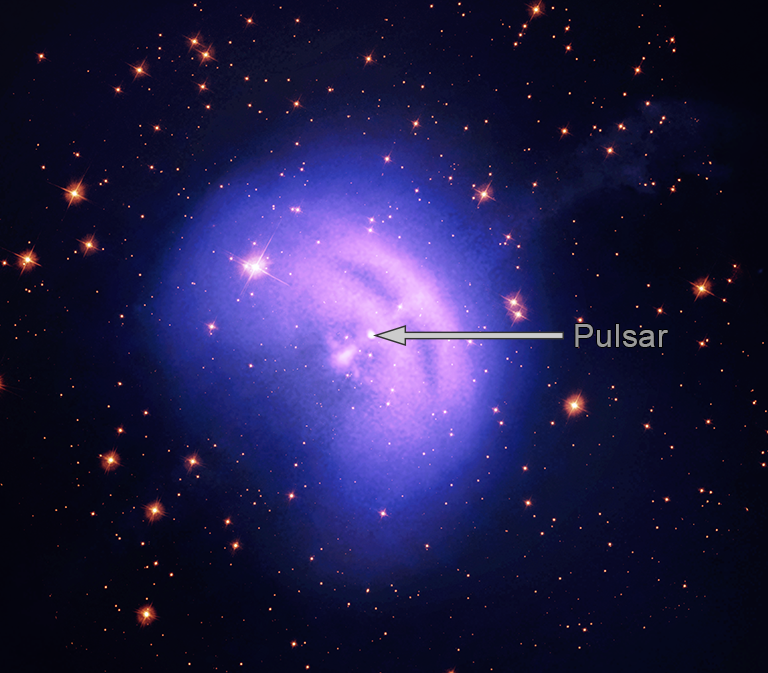13.03.2023
About 10,000 years ago, light from the explosion of a giant star in the constellation Vela arrived at Earth. This supernova left behind a dense object called a pulsar, which appears to brighten regularly as it spins, like a cosmic lighthouse. From the surface of this pulsar, winds of particles emerge that travel near the speed of light, creating a chaotic hodgepodge of charged particles and magnetic fields that crash into surrounding gas. This phenomenon is called a pulsar wind nebula.

In this new image, the hazy light blue halo corresponds to the first-ever X-ray polarization data for Vela, which comes from NASA’s Imaging X-ray Polarimetry Explorer, or IXPE. A faint blue fuzzy line pointing to the upper right-hand corner corresponds to a jet of high-energy particles shooting out from the pulsar at about half the speed of light. The pink X-ray "arcs" are thought to mark the edges of donut-shaped regions where the pulsar wind shocks and accelerates high-energy particles. The pulsar itself is located at the white circle at the center of the image.
Pink and purple colors correspond to data from NASA’s Chandra X-ray Observatory, which has observed Vela several times previously. The golden stars were captured by NASA’s Hubble Space Telescope.
Measuring polarization, which has to do with how electromagnetic waves are organized, gives scientists an unprecedented understanding of how a cosmic object like a pulsar accelerates particles to high speeds.
“With IXPE, we are using extreme objects like Vela as a laboratory to investigate some of the most pressing questions in astrophysics, such as how particles get catapulted to near the speed of light long after a star has exploded,” said Phil Kaaret, senior scientist at NASA’s Marshall Space Flight Center in Huntsville, Alabama.
In a recent study, scientists were surprised about the high degree of polarization they found in the X-rays at the Vela pulsar wind nebula. IXPE observations of this object were published in the journal Nature in December.
“This is the highest degree of polarization measured in a celestial X-ray source to date,” said Fei Xie, lead author of the Nature study, professor at Guangxi University in Nanning, Guangxi, China, and formerly a postdoctoral researcher at Italy's National Institute for Astrophysics/Institute for Space Astrophysics and Planetology (INAF/IAPS) in Rome.
High polarization means that the electromagnetic fields are well organized; they are lined up in specific directions, and depend on their position in the nebula. What’s more, the X-rays that IXPE detects come from high-energy electrons spiraling in the magnetic fields of the pulsar wind nebula, called “synchrotron emission.” Highly polarized X-rays means that these magnetic fields, too, must be well organized.
In contrast to supernova remnants that have a shell of material around them, the high polarization of the X-rays “suggests that the electrons were not accelerated by the turbulent shocks that seem important in other X-ray sources,” said Roger W. Romani, a Stanford astrophysicist involved in the IXPE data analysis. Instead, there must be some other process involved, such as magnetic reconnection, which involves the breaking and joining of magnetic field lines. That is a way in which magnetic energy gets converted to particle energy.
IXPE data also suggest that the magnetic field is aligned as a smooth donut-shaped structure around the equator of the pulsar. This shape was in line with scientists’ expectations.
"This IXPE X-ray polarization measurement adds a missing piece of the Vela pulsar wind nebula puzzle," says Alessandro Di Marco, a researcher at INAF/IAPS in Rome who contributed to the data analysis. "By mapping with unprecedented resolution, IXPE unveils the magnetic field in the central region, showing agreement with results obtained from radio images of the outer nebula.”
The Vela pulsar, located about 1,000 light-years from Earth, is about 15 miles (25 kilometers) in diameter and rotates 11 times per second, faster than a helicopter rotor.
About the IXPE mission
Part of NASA’s Small Explorer mission series, IXPE launched on a Falcon 9 rocket from NASA’s Kennedy Space Center in Florida in December 2021. It now orbits 370 miles, or roughly 595 kilometers, above Earth’s equator. The mission is a partnership between NASA and the Italian Space Agency, with partners and science collaborators in 13 countries. Ball Aerospace, headquartered in Broomfield, Colorado, manages spacecraft operations.
Quelle: NASA

